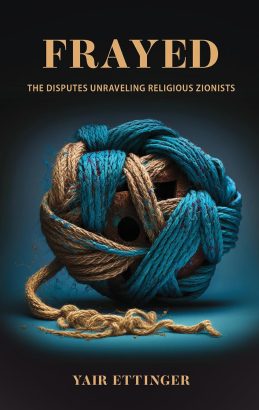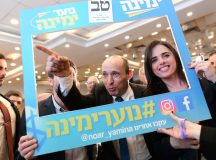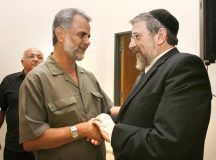Longtime observer and chronicler of the religious community Yair Ettinger’s[1] bestselling 2020 book on the religious Zionist community has now been translated, allowing English speakers a deeper look into this important and influential part of Israeli society.
Ettinger’s book helps both insiders and outsiders to peel away some of the stereotypes and tropes often attached to the religious Zionist community, allowing them to better understand the various nuances and trends. Most readers will only be familiar with the politics of religious Zionism, if at all. Frayed takes us beyond that layer and into areas that will have long term impact on Israeli religious society, and potentially at a later date, the politics as well.
Privatisation
Ettinger describes an Israeli form of Judaism developing from the bottom-up that can not necessarily be located on the typical dichotomy of liberal versus conservative or moderate versus radical. Instead Ettinger describes a dynamic between more and less conservative elements within the religious Zionist community. For example, on the one hand the increasing normalisation of visiting the Temple Mount crosses the usual intra-communal boundaries of religiosity and right-left politics.[2] ‘A diverse lot’ Ettinger calls them, ‘split into dozens of groups, from mass organisations to relatively minor factions.’ On the other hand, the huge increase in numbers of religious girls volunteering for army service reflects a more liberal versus conservative trend, (and even this trend has crossed the Rubicon, now including greater numbers of alumni from more conservative girls’ high schools.)
In a 2014 article, Dr. Shlomo Fischer,[3] a sociologist and a senior staff member of the Jewish People Policy Institute (JPPI) in Jerusalem, offers an explanation for Ettinger’s thesis. Fischer sees it as a natural extension of what he terms the expressivist tendencies of the nationalist religious Zionism as its focus shifted from attaching religious and messianic importance to Israel’s national institutions, (even including mundane but national activities as reflections of the Divine plan), towards a more individualised sense of religious expression. Fischer argues that ‘self-expression, self-actualisation, freedom, authenticity, and self-recognition has been reformulated and reinterpreted such that they refer to the individual, not only to the collective of the Jewish nation.’[4] As a generality Ettinger considers this a form of socio-religious privatisation, which leads to less reliance on rabbinic direction and a weakening rabbinic authority. This contrasts to the much more hierarchical ultra-Orthodox Haredi branch of religious Judaism and the more conservative branches within the nationalist religious community.
Empowered Religious Feminism
One of the strongest reflections of this privatisation trend is an increasingly confident religious feminism resulting in more female spiritual leadership and equality within synagogue or quasi-synagogue environments. This is of course not only an individual form or religious privatization as there is a need for institutional solutions for study and training for religious female leadership and synagogues and communities prepared to adopt such leaders. Although this would seem to come at time when general rabbinic authority is dwindling, the irony may be false. Rabbinic authority for women is being driven by a more grassroots desire and hence the authority may be perceived differently. Time will tell, and by way of example women who approach Yoaztot Halacha [literally female advisors on Jewish law][5] do so by choice and consciously or otherwise reflect a renewed acceptance of rabbinic authority. This is counter to the trend that Ettinger repeats of diminishing rabbinic authority.
Army Service for Religious Girls
Ettinger dedicates a chapter to the growing trend of religious girls joining the IDF – a uniquely Israeli story compared to questions of Torah study and leadership roles for women that we will touch on later.
The numbers only tell part of the story. Ettinger quotes official IDF data that between 2008-2019 the percentage of religious girls volunteering for army service rose from 18.5 percent to around 30 percent. Data from Aluma,[6] an organisation founded by the Religious Kibbutz Movement to support and promote the option of IDF service for religious girls, shows that prior to the current war, 36 per cent of religious girls were serving in the military. Following the events of October 7, over 400 religious girls that had previously planned on doing national service (rather than being conscripted) decided to join the IDF.[7] These 400 constitute about 5 percent of the total year group of religious girls – a huge shift in such a short time. One can only speculate as to the motivation for such a shift, but the tragic events of October 7 included many female soldiers and officers who performed heroic acts during the fierce fighting with Hamas.
Historically this trend began in the religious kibbutzim, later spreading to the more liberal or ‘open’ religious girls’ high schools. More recently an increasing percentage of girls graduating from more religiously conservative high schools are also enlisting, against the historic norm and directive of the school leadership.
When I spoke to Aluma CEO Dr. Tammy Halamish-Eisenmann, she provided some important insights beyond the numbers:
Religious girls are raised in super-Zionist homes in which army service is considered a mission and an ideal. The girls are exposed to the emphasis given to the importance of military service (mainly for boys), but once this opportunity became open to them they are choosing to realise this ideal, in spite of the neutral or often negative view of parents and teachers regarding them conscripting. On a deeper level, we can see a clash between a socio-legal religious point of view on the one hand (that girls can’t – or shouldn’t – fight in combat units) versus the value of a meaningful army service on the other. Many of the girls make the feminist choice. Confident that they can maintain their personal religious commitment within the army, they aspire to the maximum contribution in the IDF, which now includes combat roles.
This explains the underlying motivation for more girls joining the army. As Halamish-Eisenmann told me, there is a second parameter that seems to be important, and it is socio-economic rather than religious:
Most of the increase in religious girls choosing to conscript comes from high schools in Jerusalem and cities in the centre of the country that tend to have stronger socio-economic characteristics. These students recognise the contribution of military service and its impact on future academic and employment potential. They see army service as the key gateway to being a more successful (and integrated) Israeli. At the same time, the number of conscripts from religious girls’ high schools in the social and geographic periphery is actually falling. This is seemingly due to both the characteristics of the population and the fact that the teachers in these schools are from the Hardal[8] or Haredi camps, who strongly oppose army service for girls.
Not only do the numbers continue to increase, but the types of roles religious girls perform in the army have also changed. Initially, religious girls primarily confined themselves to roles within the education corps, followed by more joining military intelligence. Now however, religious girls are being drafted into combat roles. Although still the minority, the desire is clear and the numbers seem to be growing. In this, (as with other trends within the religious Zionist community), religious girls mirror the battle within secular society for roles for female soldiers within the IDF.
This has generated controversy, particularly within the more conservative ‘Har Hamor’ institutions and rabbis. It has led to very negative rhetoric, including the now infamous speeches by prominent Rabbis from the pre-army academy Bnei David in the West Bank settlement of Eli. Yigal Levenstein accused the IDF of making ‘our girls crazy’[9] while Yosef Kelner derogatorily termed female soldiers as bachurilot,[10] a term meaning a cross between girls and guerillas. As with many of the debates within the religious Zionist community they have moved from a purely religious or Halachic polemic to full adoption of the language of the twenty first century culture wars.
In spite of the ultra-conservative backlash, the trend is clear and beyond the point of no return. And given the scale of the trend it will almost certainly have a wider impact on the religious Zionist community as this newly empowered group of religious women form homes and build families in the coming years.
‘Religious Feminism’ in America and Israel – A Transnational Divergence
In the 1980’s there was much debate within the Rabbinic leadership of the American Modern Orthodox community around Talmud being taught to women and the development of women’s prayer groups. The head of Yeshiva University, Rabbi Joseph Soloveitchik[11] – considered to be the most important leader of American Modern Orthodoxy in the twentieth century – inaugurated Talmud study for female students in 1977. After a false start, it was Rabbi Moshe Kahn whose tenacity made it a more permanent reality from 1984 and onwards.[12]
Rabbi’s Soloveitchik’s pupils, such as Rabbi Shlomo Riskin and Rabbi Aharon Lichtenstein – both of whom moved to Israel – have been at the forefront of a movement to deepen advanced Torah and Halachic studies for women. (Lichtenstein was heir apparent to Soloveitchik at Yeshiva University before making Aliya in the early 1970’s.) Lichtenstein’s daughter, Rabbanit Esti Rosenberg,[13] founded the Stella K. Abraham Beit Midrash for Women in 1997 (known by most simply as Migdal Oz). It has become thought of as the sister institution to the successful and highly influential Har Etzion Yeshiva[14] that her father led along with Rabbi Yehuda Amital, and which became the lead yeshiva for the Gush branch of religious Zionism[15]. It is now considered a flagship institution in its own right.
It is no coincidence that before founding Migdal Oz, Rabbanit Rosenberg led the Beit Midrash of Midreshet Lindenbaum,[16] the flagship womens’ institution for serious Torah study, founded by Riskin another of Soloveitchik’s star pupils, who made Aliya in 1983 with many of his Lincoln Square community in Manhattan to create the Judean settlement of Efrat. In addition to continuing life as a community Rabbi, he has become a successful institutional builder, marked by a more liberal approach to Halacha and religious-societal questions.
In stark contrast, another of Rabbi Soloveitchik’s most prominent pupils, Rabbi Hershel Schachter, who became Dean at the Rabbi (American) Isaac Elhanan Theological Seminary, (the Rabbinic seminary of Yeshiva University) issued a vociferous attack on emerging Orthodox feminism, equating it with historic heretical movements within Judaism.[17] In 2015, another of the institution heads, Rabbi Mordechai Willig, wrote an article which called into question the very innovation of formal organised and institutionally backed Talmud and Halacha studies for women.[18] He joins Schachter in identifying the progress made by religious women in study, and more importantly in leadership and authority as no longer an advance of Judaism, but a threat.
It is fascinating to see the institutional progress religious Israeli women have made in contrast to the counter trend that seems to be taking hold in America. Indeed, the comparison is stark as on both sides of the Atlantic – with both the trend and counter-trend led by prominent students of Soloveitchik.
Sectoral Politics
For a community that aspires to be Israel’s new elite – replacing the Kibbutzim and founders of the state – this book tells us a story of a sector that can find fewer and fewer things to agree upon, and with a very limited ability to bring its values and strengths together in a single political force. Albeit the first chapter tells us of the rise and fall of the Bennett government, a story worth telling, but ends at that point, prior to the establishment of the current coalition. It is beyond my scope to deal with this issue in full, but in recent years the more conservative wings of the community have become more dominant political players. There a number of religious Zionist ministers in the government. Two of the most important and powerful positions are held by religious Zionist politicians, Betzalel Smotrich as Finance Minister and Itamar Ben-Gvir as Minister for National Security, both of whom hold ultra-right opinions. Indeed, Ben-Gvir is a follower of the extreme right Rabbi Meir Kahane.[19]
Whilst Frayed shows us a much more diverse picture within the sector (born out by data from various polls) it does not translate into more diversified or devolved political power. There are many reasons for this, and one would hope that Ettinger or someone else address this separately. There are many factors at play, and I would suggest three key ones. The first and most important is to remember that issues of security and West Bank settlements are the religious Zionist community’s top political priorities. No matter where one stands on other religious and social issues, they are considered secondary when it comes to voting. In addition, the religious Zionist sector still likes to vote as a sector, and Smotrich is the only serious sectoral choice at the moment (particularly following Naftali Bennett exit from politics). Finally, those who oppose Smotrich in world-view and politics do not see themselves as representatives of the religious Zionist sector. This frees them for answering to sectoral issues, but also impairs their ability to build a political base with the religious community.
Education Holds Everyone Together
The other interesting arena not touched upon in the book is the State Religious education system. This (along with right wing political-security views) is the only other consensus issue for the religious Zionist community. Pretty much everyone participates.
Although it has itself become more diverse in terms of the types of schools and the variety of religious and academic offerings, the ‘State Religious Education’ department within the Education Ministry is still seen as the home for all the different factions of the sector. However, and in some ways, it is the proof that it is still very much considered an asset that belongs to the whole sector, it is the object of serious politicking. Key bureaucratic and educational appointments, content, policy and budgets, are all the focus of the different factions. Each trying to leverage its position, or some feeling the need to defend their position. (See note 19 for more). As long as Israel’s education system is structured along separate state-secular (mamlachti), religious, Haredi and Arab streams, this will remain the case, and as with society in general, understanding the trends within education is to understand the future of the society.
Hard Data
Where the book comes a little short is bringing empirical data indicating how the religious Zionist community falls between the two camps, the more conservative Hardal, or the more liberal branches, and their views on the issues Ettinger highlights. It was partially the reading of the book in Hebrew that pushed me and a group of activists to create The Institute for Jewish and Zionist Research. It has looked at and polled the religious and traditional communities on various questions: Religion and state, religious girls and the IDF, the place of LGBT members within synagogue and others. Not surprisingly (at least to me) we have found a community with much more liberal views that the political representatives reflect, at the same time as shifting more to the right on issues of security and settlements. The data certainly supports the insights that Frayed offers about the community, although it cannot answer which direction it may head in the future or how the sectoral politics will play out.
Conclusion and Recommendation
Frayed allows a partial but highly indicative view of diverging religious responses to modernity. This includes a range of discussions about competing narratives on feminism and the position of women as religious leaders; about LGBT and how modern religion should be relating to gay and lesbian co-religionists that seek to remain inside a religious community; and whether a religious monopoly in the shape of the Israeli Chief Rabbinate remains part of a messianic theme, or is at the heart of the religious problem of the Jewish State.
It is impossible to finish such an analysis without considering the huge contribution and terrible sacrifice made by young members and alumni of the religious Zionist community during the current war. There have been several articles analysing the relative number of religious soldiers that have been killed since October 7, in stark contrast to the ultra-Orthodox community that has looked out of touch and under attack. How this affects the relationship between the religious Zionist community and other parts of Israeli society will have to wait until Ettinger’s next book. Or so I would hope.
In the book’s preface, the ever-thoughtful Brandeis Professor Yehudah Mirsky[20] wrote the following, and I’m not sure I can improve on his words.
Ettinger’s writing, free from ideological anxieties and academic theorising, opens a thrilling window into the vitality and richness, in celebration and struggle, of being a free people in the Land of Israel. And like all good books, is an invitation to more conversations, among and within ourselves.
I humbly add my own warm recommendations to Frayed: it will be interesting, informative and thought provoking for anyone interested in the future of Israeli society.
[1] https://www.kan.org.il/authors/%D7%99%D7%90%D7%99%D7%A8-%D7%90%D7%98%D7%99%D7%A0%D7%92%D7%A8/
[2] Ettinger describes the group that ascends Temple Mount as a highly diverse bunch with various different motivations. ‘The Temple Mount loyalists, or mikdashnikim, are a diverse lot. They are split into dozens of groups, from mass organizations to relatively minor factions. Some prioritise displays of strength, accentuating Israeli sovereignty at the site, even though the government of Israel, shortly after seizing control of the area during the 1967 war, surrendered its administration to the Waqf, an Islamic religious agency overseen by Jordan. Others wish to pray there – an act of worship that is forbidden to Jews – or simply to visit. Some go much farther and want to move toward the construction of the Third Temple, training themselves in the intricacies of its rituals and animal sacrifices. What will happen to the two Islamic sites on the Temple Mount, which Muslims around the world flock to and revere? Some Temple Mount activists hope to destroy them, plain and simple. Others, such as Yehudah Glick, dream of a ‘house of prayer for all peoples, as Isaiah prophesies, a utopia of interreligious harmony radiating out from the Mount.’ P.135
[3] https://jppi.org.il/en/staff/staff/
[4] Fischer, S. (2014). ‘7 Two Orthodox Cultures: “Centrist” Orthodoxy and Religious Zionism’. In Reconsidering Israel-Diaspora Relations. Leiden, The Netherlands: Brill. https://doi.org/10.1163/9789004277076_009
[5] Literally, Jewish Law Adviser. An innovation of recent decades giving a limited ordainment to women for halachic adjudication on matters specifically pertaining to women. https://en.wikipedia.org/wiki/Yoetzet_halacha
[6] https://www.aluma.org.il/en/program/serving-with-faith/
[7] From a conversation with the author based on data he received from the IDF.
[8] For more detail on ‘Hardal’ and the ‘Har Hamor’ faction and its political rise see https://fathomjournal.org/small-vote-great-power-rabbi-tau-avi-maoz-the-noam-party-and-the-threat-to-equal-rights-in-israel/
[9] https://www.timesofisrael.com/homophobic-rabbi-who-mentors-soldiers-says-idf-turns-women-crazy/
[10] https://www.srugim.co.il/238338-%D7%94%D7%A8%D7%91-%D7%A7%D7%9C%D7%A0%D7%A8-%D7%94%D7%A0%D7%A9%D7%99%D7%9D-%D7%91%D7%99%D7%9E%D7%99%D7%A0%D7%95-%D7%94%D7%9F-%D7%9B%D7%9C%D7%95%D7%9D-%D7%98%D7%9E%D7%98%D7%9E%D7%95-%D7%90%D7%95
[11] “Rabbi Yosef Dov was the most influential figure associated with the spread of Torah in America, and he was singularly known as “the Rav.” https://www.yu.edu/riets/about/mission-history
[12] https://yucommentator.org/2023/04/letter-to-the-editor-the-myth-the-history-and-the-lesson-of-the-ravs-stern-talmud-shiur/
[13] Rabbi Aharon Lichtenstein was Rabbi Soloveitchik’s son-in-law, making Rabbanit Rosenberg Soloveitchik’s granddaughter.
[14] https://www.haretzion.org/about-us
[15] Literally the Block – for a broader description of the network of institutions and influence of the Gush see – https://en.wikipedia.org/wiki/Yeshivat_Har_Etzion
[16] Midreshet Lindenbaum was founded in 1976 by Rabbi Chaim Brovender prior to the founding of Ohr Torah Stone, and was later integrated into the network. https://www.lind.org.il/
[17] For an analysis of Rabbi Schachter’s approach see: “Feminism and Heresy: The Construction of a Jewish Metanarrative” Adam S. Ferziger, Journal of the American Academy of Religion, Vol. 77, No. 3 (Sep., 2009), pp. 494-546. It should not be a surprise that Rabbi Schachter chose to speak at the Kenes Tzion v’Yerushalayim in 2016 arranged by the ultra-conservative Liba Center, associated with the Yeshivat Har Hamor branch of religious Zionism. Here is his speech https://www.youtube.com/watch?v=Cc4BuupsD5g
[18] Rabbi Willig even quotes Ettinger, who wrote that ‘According to (Dr Tamar) Ross, what is happening today is a direct continuation of the beginning of Talmud studies for religious women in the 1980s.’ Willig responds to Ross directly in ‘Trampled Laws’ – ‘This candid admission must, for the genuinely Orthodox, call into question the wisdom of these studies.’
[19] https://en.wikipedia.org/wiki/Kahanism
[20] Mirsky’s latest book Rav Kook: Mystic in a Time of Revolution brings new scholarship to one of the most important and influential figures in religious Zionism.




































